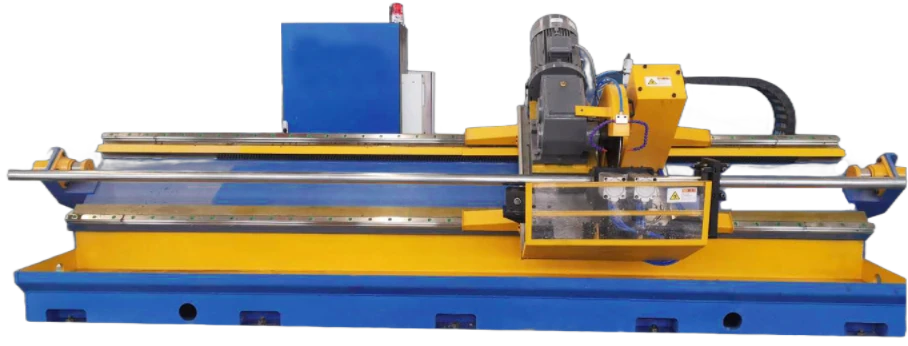Stud Roll Forming Equipment for Efficient Metal Fabrication Solutions
Understanding the Roll Forming Process A Look at Stud Roll Forming Machines
Roll forming is a popular manufacturing process often used in metalworking to create long sections of metal with a consistent cross-section. One specific application of roll forming is in the production of stud tracks used in building construction and other applications. Stud roll forming machines have become essential tools for manufacturers looking to produce high-quality metal framing components more efficiently and economically.
The Roll Forming Process
Roll forming involves feeding a metal strip through a series of rollers, mechanically manipulating it to achieve the desired shape. The rollers gradually bend and shape the metal without cutting it, which means there is little waste produced. This continuous process allows for high production rates and creates consistent profiles that meet stringent industry standards.
In the context of stud roll forming, the machine takes a flat sheet of metal, typically steel, and shapes it into studs—vertical members in a wall system that provide structural support. The machine's rollers are specifically designed to produce various profiles, including C-shaped or U-shaped sections, depending on the application requirements.
Features of Stud Roll Forming Machines
Stud roll forming machines are equipped with several features that contribute to their efficiency and versatility. Here are some key components that define these machines
1. High-speed Operation Modern stud roll forming machines can operate at high speeds, significantly increasing productivity. This capability is essential for manufacturers looking to meet market demands without compromising the quality of the output.
2. Adjustable Rollers The ability to adjust the rollers allows manufacturers to create different stud profiles easily. This flexibility is crucial, as construction projects often require various sizes and shapes of studs to accommodate different design specifications.
3. Integrated Cutting Mechanisms Many stud roll forming machines come with integrated cutting systems that can be programmed to cut the formed studs to predetermined lengths. This integration reduces the need for secondary cutting processes and streamlines production.
stud roll forming machine

4. Automated Control Systems Advanced machines feature PLC (Programmable Logic Controller) systems, which control the entire operation of the roll forming process. These systems can monitor the machine's performance, adjust parameters in real-time, and ensure that the product meets quality standards.
5. Material Handling Features Since roll forming involves handling long strips of metal, effective material handling mechanisms are crucial. Many machines are equipped with automated feeding systems or conveyors that facilitate the smooth movement of materials through the production line.
Benefits of Using Stud Roll Forming Machines
Stud roll forming machines offer numerous advantages for manufacturers, including
- Cost-effectiveness By minimizing waste and reducing labor costs through automation, roll forming is a cost-efficient manufacturing method.
- Durability and Strength Roll-formed studs often exhibit enhanced structural integrity compared to other methods. The cold-forming process increases the yield strength of the material, making it more resilient.
- Rapid Production Rates The continuous nature of roll forming enables manufacturers to produce a high volume of products in a shorter timeframe, meeting tight project deadlines efficiently.
- Customization Manufacturers can produce custom-designed studs tailored to specific building requirements without significant reconfiguration of the machinery.
Conclusion
Stud roll forming machines are a vital component of modern metal fabrication, particularly in the construction industry. With their efficiency, flexibility, and ability to produce high-quality products, these machines enable manufacturers to keep pace with growing demands for reliable metal framing components. As technology advances, the future of roll forming will likely bring even more innovative solutions, further enhancing the capabilities of stud roll forming machines and solidifying their role in the industry. Whether you are a builder, contractor, or manufacturer, understanding the benefits and functionalities of these machines can help you make informed decisions in your production processes.
-
High Frequency Straight Seam Welded Pipe Production Line-BzZhou Xinghua Machinery Equipment Manufacturing Co., LTD.|line pipe steel&welded gas pipeNewsJul.30,2025
-
High Frequency Straight Seam Welded Pipe Production Line-BzZhou Xinghua Machinery Equipment Manufacturing Co., LTD.|High Precision&Automated SolutionsNewsJul.30,2025
-
High Frequency Straight Seam Welded Pipe Production Line - BzZhou Xinghua Machinery Equipment Manufacturing Co., Ltd.NewsJul.30,2025
-
High Frequency Straight Seam Welded Pipe Production Line-BzZhou Xinghua Machinery Equipment Manufacturing Co., LTD.|Precision Welding, High EfficiencyNewsJul.30,2025
-
High Frequency Straight Seam Welded Pipe Production Line|BzZhou Xinghua|Precision Welding&EfficiencyNewsJul.30,2025
-
High Frequency Straight Seam Welded Pipe Production Line - BzZhou Xinghua|Precision Engineering&EfficiencyNewsJul.30,2025


